Input interpretation

H_2O water + Na_2SO_4 sodium sulfate ⟶ O_2 oxygen + H_2 hydrogen + NaOH sodium hydroxide + SO_2 sulfur dioxide
Balanced equation
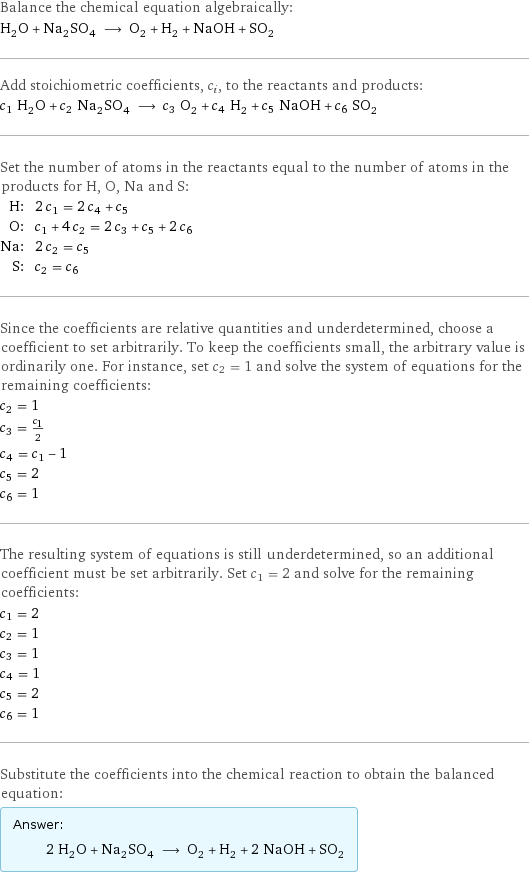
Balance the chemical equation algebraically: H_2O + Na_2SO_4 ⟶ O_2 + H_2 + NaOH + SO_2 Add stoichiometric coefficients, c_i, to the reactants and products: c_1 H_2O + c_2 Na_2SO_4 ⟶ c_3 O_2 + c_4 H_2 + c_5 NaOH + c_6 SO_2 Set the number of atoms in the reactants equal to the number of atoms in the products for H, O, Na and S: H: | 2 c_1 = 2 c_4 + c_5 O: | c_1 + 4 c_2 = 2 c_3 + c_5 + 2 c_6 Na: | 2 c_2 = c_5 S: | c_2 = c_6 Since the coefficients are relative quantities and underdetermined, choose a coefficient to set arbitrarily. To keep the coefficients small, the arbitrary value is ordinarily one. For instance, set c_2 = 1 and solve the system of equations for the remaining coefficients: c_2 = 1 c_3 = c_1/2 c_4 = c_1 - 1 c_5 = 2 c_6 = 1 The resulting system of equations is still underdetermined, so an additional coefficient must be set arbitrarily. Set c_1 = 2 and solve for the remaining coefficients: c_1 = 2 c_2 = 1 c_3 = 1 c_4 = 1 c_5 = 2 c_6 = 1 Substitute the coefficients into the chemical reaction to obtain the balanced equation: Answer: | | 2 H_2O + Na_2SO_4 ⟶ O_2 + H_2 + 2 NaOH + SO_2
Structures

+ ⟶ + + +
Names

water + sodium sulfate ⟶ oxygen + hydrogen + sodium hydroxide + sulfur dioxide
Reaction thermodynamics
Enthalpy
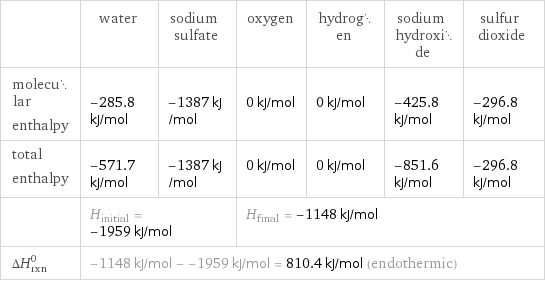
| water | sodium sulfate | oxygen | hydrogen | sodium hydroxide | sulfur dioxide molecular enthalpy | -285.8 kJ/mol | -1387 kJ/mol | 0 kJ/mol | 0 kJ/mol | -425.8 kJ/mol | -296.8 kJ/mol total enthalpy | -571.7 kJ/mol | -1387 kJ/mol | 0 kJ/mol | 0 kJ/mol | -851.6 kJ/mol | -296.8 kJ/mol | H_initial = -1959 kJ/mol | | H_final = -1148 kJ/mol | | | ΔH_rxn^0 | -1148 kJ/mol - -1959 kJ/mol = 810.4 kJ/mol (endothermic) | | | | |
Gibbs free energy
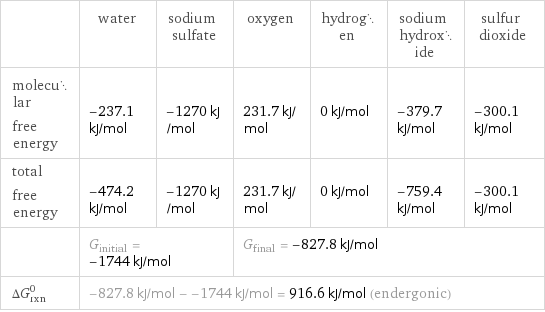
| water | sodium sulfate | oxygen | hydrogen | sodium hydroxide | sulfur dioxide molecular free energy | -237.1 kJ/mol | -1270 kJ/mol | 231.7 kJ/mol | 0 kJ/mol | -379.7 kJ/mol | -300.1 kJ/mol total free energy | -474.2 kJ/mol | -1270 kJ/mol | 231.7 kJ/mol | 0 kJ/mol | -759.4 kJ/mol | -300.1 kJ/mol | G_initial = -1744 kJ/mol | | G_final = -827.8 kJ/mol | | | ΔG_rxn^0 | -827.8 kJ/mol - -1744 kJ/mol = 916.6 kJ/mol (endergonic) | | | | |
Equilibrium constant
![Construct the equilibrium constant, K, expression for: H_2O + Na_2SO_4 ⟶ O_2 + H_2 + NaOH + SO_2 Plan: • Balance the chemical equation. • Determine the stoichiometric numbers. • Assemble the activity expression for each chemical species. • Use the activity expressions to build the equilibrium constant expression. Write the balanced chemical equation: 2 H_2O + Na_2SO_4 ⟶ O_2 + H_2 + 2 NaOH + SO_2 Assign stoichiometric numbers, ν_i, using the stoichiometric coefficients, c_i, from the balanced chemical equation in the following manner: ν_i = -c_i for reactants and ν_i = c_i for products: chemical species | c_i | ν_i H_2O | 2 | -2 Na_2SO_4 | 1 | -1 O_2 | 1 | 1 H_2 | 1 | 1 NaOH | 2 | 2 SO_2 | 1 | 1 Assemble the activity expressions accounting for the state of matter and ν_i: chemical species | c_i | ν_i | activity expression H_2O | 2 | -2 | ([H2O])^(-2) Na_2SO_4 | 1 | -1 | ([Na2SO4])^(-1) O_2 | 1 | 1 | [O2] H_2 | 1 | 1 | [H2] NaOH | 2 | 2 | ([NaOH])^2 SO_2 | 1 | 1 | [SO2] The equilibrium constant symbol in the concentration basis is: K_c Mulitply the activity expressions to arrive at the K_c expression: Answer: | | K_c = ([H2O])^(-2) ([Na2SO4])^(-1) [O2] [H2] ([NaOH])^2 [SO2] = ([O2] [H2] ([NaOH])^2 [SO2])/(([H2O])^2 [Na2SO4])](../image_source/004a179e4c0358f12c882ff5093abf53.png)
Construct the equilibrium constant, K, expression for: H_2O + Na_2SO_4 ⟶ O_2 + H_2 + NaOH + SO_2 Plan: • Balance the chemical equation. • Determine the stoichiometric numbers. • Assemble the activity expression for each chemical species. • Use the activity expressions to build the equilibrium constant expression. Write the balanced chemical equation: 2 H_2O + Na_2SO_4 ⟶ O_2 + H_2 + 2 NaOH + SO_2 Assign stoichiometric numbers, ν_i, using the stoichiometric coefficients, c_i, from the balanced chemical equation in the following manner: ν_i = -c_i for reactants and ν_i = c_i for products: chemical species | c_i | ν_i H_2O | 2 | -2 Na_2SO_4 | 1 | -1 O_2 | 1 | 1 H_2 | 1 | 1 NaOH | 2 | 2 SO_2 | 1 | 1 Assemble the activity expressions accounting for the state of matter and ν_i: chemical species | c_i | ν_i | activity expression H_2O | 2 | -2 | ([H2O])^(-2) Na_2SO_4 | 1 | -1 | ([Na2SO4])^(-1) O_2 | 1 | 1 | [O2] H_2 | 1 | 1 | [H2] NaOH | 2 | 2 | ([NaOH])^2 SO_2 | 1 | 1 | [SO2] The equilibrium constant symbol in the concentration basis is: K_c Mulitply the activity expressions to arrive at the K_c expression: Answer: | | K_c = ([H2O])^(-2) ([Na2SO4])^(-1) [O2] [H2] ([NaOH])^2 [SO2] = ([O2] [H2] ([NaOH])^2 [SO2])/(([H2O])^2 [Na2SO4])
Rate of reaction
![Construct the rate of reaction expression for: H_2O + Na_2SO_4 ⟶ O_2 + H_2 + NaOH + SO_2 Plan: • Balance the chemical equation. • Determine the stoichiometric numbers. • Assemble the rate term for each chemical species. • Write the rate of reaction expression. Write the balanced chemical equation: 2 H_2O + Na_2SO_4 ⟶ O_2 + H_2 + 2 NaOH + SO_2 Assign stoichiometric numbers, ν_i, using the stoichiometric coefficients, c_i, from the balanced chemical equation in the following manner: ν_i = -c_i for reactants and ν_i = c_i for products: chemical species | c_i | ν_i H_2O | 2 | -2 Na_2SO_4 | 1 | -1 O_2 | 1 | 1 H_2 | 1 | 1 NaOH | 2 | 2 SO_2 | 1 | 1 The rate term for each chemical species, B_i, is 1/ν_i(Δ[B_i])/(Δt) where [B_i] is the amount concentration and t is time: chemical species | c_i | ν_i | rate term H_2O | 2 | -2 | -1/2 (Δ[H2O])/(Δt) Na_2SO_4 | 1 | -1 | -(Δ[Na2SO4])/(Δt) O_2 | 1 | 1 | (Δ[O2])/(Δt) H_2 | 1 | 1 | (Δ[H2])/(Δt) NaOH | 2 | 2 | 1/2 (Δ[NaOH])/(Δt) SO_2 | 1 | 1 | (Δ[SO2])/(Δt) (for infinitesimal rate of change, replace Δ with d) Set the rate terms equal to each other to arrive at the rate expression: Answer: | | rate = -1/2 (Δ[H2O])/(Δt) = -(Δ[Na2SO4])/(Δt) = (Δ[O2])/(Δt) = (Δ[H2])/(Δt) = 1/2 (Δ[NaOH])/(Δt) = (Δ[SO2])/(Δt) (assuming constant volume and no accumulation of intermediates or side products)](../image_source/cd21bb86a810cba01daf5a7136ffe3eb.png)
Construct the rate of reaction expression for: H_2O + Na_2SO_4 ⟶ O_2 + H_2 + NaOH + SO_2 Plan: • Balance the chemical equation. • Determine the stoichiometric numbers. • Assemble the rate term for each chemical species. • Write the rate of reaction expression. Write the balanced chemical equation: 2 H_2O + Na_2SO_4 ⟶ O_2 + H_2 + 2 NaOH + SO_2 Assign stoichiometric numbers, ν_i, using the stoichiometric coefficients, c_i, from the balanced chemical equation in the following manner: ν_i = -c_i for reactants and ν_i = c_i for products: chemical species | c_i | ν_i H_2O | 2 | -2 Na_2SO_4 | 1 | -1 O_2 | 1 | 1 H_2 | 1 | 1 NaOH | 2 | 2 SO_2 | 1 | 1 The rate term for each chemical species, B_i, is 1/ν_i(Δ[B_i])/(Δt) where [B_i] is the amount concentration and t is time: chemical species | c_i | ν_i | rate term H_2O | 2 | -2 | -1/2 (Δ[H2O])/(Δt) Na_2SO_4 | 1 | -1 | -(Δ[Na2SO4])/(Δt) O_2 | 1 | 1 | (Δ[O2])/(Δt) H_2 | 1 | 1 | (Δ[H2])/(Δt) NaOH | 2 | 2 | 1/2 (Δ[NaOH])/(Δt) SO_2 | 1 | 1 | (Δ[SO2])/(Δt) (for infinitesimal rate of change, replace Δ with d) Set the rate terms equal to each other to arrive at the rate expression: Answer: | | rate = -1/2 (Δ[H2O])/(Δt) = -(Δ[Na2SO4])/(Δt) = (Δ[O2])/(Δt) = (Δ[H2])/(Δt) = 1/2 (Δ[NaOH])/(Δt) = (Δ[SO2])/(Δt) (assuming constant volume and no accumulation of intermediates or side products)
Chemical names and formulas
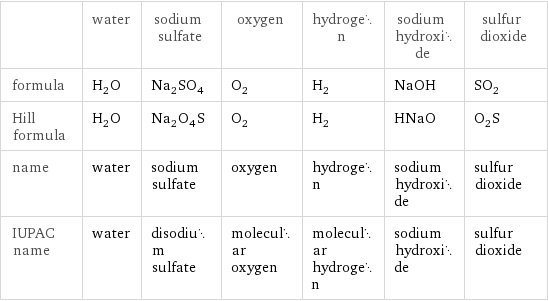
| water | sodium sulfate | oxygen | hydrogen | sodium hydroxide | sulfur dioxide formula | H_2O | Na_2SO_4 | O_2 | H_2 | NaOH | SO_2 Hill formula | H_2O | Na_2O_4S | O_2 | H_2 | HNaO | O_2S name | water | sodium sulfate | oxygen | hydrogen | sodium hydroxide | sulfur dioxide IUPAC name | water | disodium sulfate | molecular oxygen | molecular hydrogen | sodium hydroxide | sulfur dioxide
Substance properties
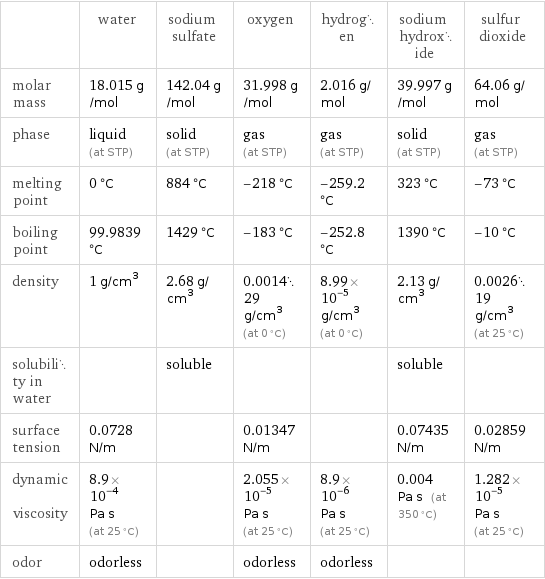
| water | sodium sulfate | oxygen | hydrogen | sodium hydroxide | sulfur dioxide molar mass | 18.015 g/mol | 142.04 g/mol | 31.998 g/mol | 2.016 g/mol | 39.997 g/mol | 64.06 g/mol phase | liquid (at STP) | solid (at STP) | gas (at STP) | gas (at STP) | solid (at STP) | gas (at STP) melting point | 0 °C | 884 °C | -218 °C | -259.2 °C | 323 °C | -73 °C boiling point | 99.9839 °C | 1429 °C | -183 °C | -252.8 °C | 1390 °C | -10 °C density | 1 g/cm^3 | 2.68 g/cm^3 | 0.001429 g/cm^3 (at 0 °C) | 8.99×10^-5 g/cm^3 (at 0 °C) | 2.13 g/cm^3 | 0.002619 g/cm^3 (at 25 °C) solubility in water | | soluble | | | soluble | surface tension | 0.0728 N/m | | 0.01347 N/m | | 0.07435 N/m | 0.02859 N/m dynamic viscosity | 8.9×10^-4 Pa s (at 25 °C) | | 2.055×10^-5 Pa s (at 25 °C) | 8.9×10^-6 Pa s (at 25 °C) | 0.004 Pa s (at 350 °C) | 1.282×10^-5 Pa s (at 25 °C) odor | odorless | | odorless | odorless | |
Units
